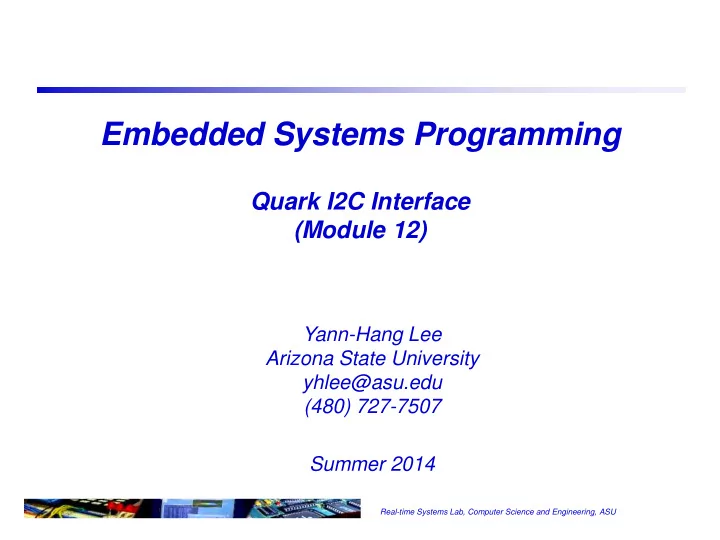

Embedded Systems Programming Quark I2C Interface (Module 12) Yann-Hang Lee Arizona State University yhlee@asu.edu (480) 727-7507 Summer 2014 Real-time Systems Lab, Computer Science and Engineering, ASU
Bit-Transfer on I2C Bus One clock pulse is generated for each data bit that is transferred Data Validity The data on the SDA line must be stable during the HIGH(1) period of the clock. The data line(SDA) can change data only when the clock signal (SCL) is LOW(0) Wired-and function open-drain or open- collector 1 Real-time Systems Lab, Computer Science and Engineering, ASU
Data Transfer With 7-Bit Device Address After START condition (S), a slave address(7-bit) is sent. A read/write (R/W’) direction is then sent(8th bit) Data transfer occurs, and then always terminated by STOP condition. However, repeated START conditions can occur. 2 Real-time Systems Lab, Computer Science and Engineering, ASU
Master-Transmitter to Slave-Receiver Data Transfer In this, the transmission direction never changes. The set-up and transfer is straight-forward 3 Real-time Systems Lab, Computer Science and Engineering, ASU
Master-Receiver and Slave-Transmitter Data Transfer Master initiates the data transfer by generating the START condition followed by the start byte (with read/write bit set to 1 i.e. read mode) After the first ack from the slave, the direction of data changes and the master becomes receiver and slave transmitter. The STOP condition is still generated by the master (master sends not-ACK before generating the STOP) 4 Real-time Systems Lab, Computer Science and Engineering, ASU
Example I2C Device – 24FC256 EEPROM 32K bytes in 512 pages of 64 bytes I2C interface with A2, A1, A0 address pins Page write operation: Random read operation: 5 Real-time Systems Lab, Computer Science and Engineering, ASU
Example: I2C and GPIO in Quark A PCI device: B:0, D:21, F:2 MMIO – use two base registers in configuration registers Offset Start Offset End Register ID Default Value 10h 13h BAR0 00000000h 14h 17h BAR1 00000000h I2C memory registers – BAR0+offset I2C Master mode operation Disable the I2C controller by writing 0 to IC_ENABLE.ENABLE. Write to the IC_CON register Write to the IC_TAR register. Enable the I2C controller by writing a 1 in IC_ENABLE. Write the transfer direction and data to be sent to the IC_DATA_CMD register. 6 Real-time Systems Lab, Computer Science and Engineering, ASU
Example: Quark GPIO IRQ Enable Allows each bit of Port A to be configured for interrupts. In drivers/mfd/intel_cln_gip_gpio.c, #define PORTA_INT_EN 0x30 /* Interrupt enable */ #define PORTA_INT_MASK 0x34 /* Interrupt mask */ #define PORTA_INT_TYPE_LEVEL 0x38 /* Interrupt level*/ . . . . . . . static void intel_cln_gpio_irq_enable(struct irq_data *d) { . . . . void __iomem *reg_inte = reg_base + PORTA_INT_EN; gpio = d->irq - irq_base; spin_lock_irqsave(&lock, flags); val_inte = ioread32(reg_inte); iowrite32(val_inte | BIT(gpio % 32), reg_inte); spin_unlock_irqrestore(&lock, flags); } 7 Real-time Systems Lab, Computer Science and Engineering, ASU
I2C Controller in Quark GIP controller: Bus 0, Device 21, Function 2 PCI configuration registers Base Address Register (BAR0) — Offset 10h Base Address Register (BAR1) — Offset 14h I2C Controller Memory Mapped Registers – Based on BAR0 register offsets are defined in /deriver/i2c/buses/i2c-designware-core.c I2C algorithm static struct i2c_algorithm i2c_dw_algo = { .master_xfer = i2c_dw_xfer, .functionality = i2c_dw_func, }; major steps of i2c_dw_xfer in i2c-designware-core.c, i2c_dw_wait_bus_not_busy(dev); i2c_dw_xfer_init(dev); /* wait for tx to complete */ wait_for_completion_interruptible_timeout to write to control reg: dw_writel(dev, 1, DW_IC_ENABLE); /* Enable the adapter */ 8 Real-time Systems Lab, Computer Science and Engineering, ASU
Recommend
More recommend